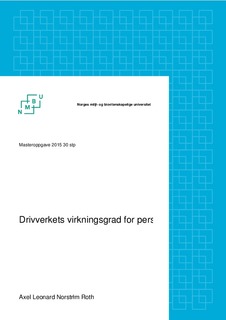| dc.description.abstract | IMT at NMBU wanted a literature research that provides relevant data in order to estimate powertrain losses on modern vehicles. Secondarily, the research contains formulas that can be used to calculate these losses. It was therefore desirable to control existing theory and formulas towards practical testing.
The goal of this assignment was to perform a literature research on passenger car powertrains with its losses and also to test selected passanger vehicles to the existing formulas. The tests carried out are used as an indication of whether the results correlate with the efficiency in modern powertrains and if improvement has been made.
In course of the assignment it is performed a literature research that addresses powertrain with corresponding losses in passenger cars as well as information on dynamometers. Furthermore, tests on a rolling dynamometer were performed on a Toyota Auris and GT86.
Among the books / standards with reference wit the subject it is further recommended to familiarize with the following litterature.
- Kjøretøymotorer[13]: Literature which is advised because it contains Jantes empirical equation for calculation of powertrain losses. On the contrary, I found certain aspects of the literature to be outdated.
- Motorteknikk[20]: This is a book that adresses details in powertrain literature which makes it a good supplement to the above mentioned book.
- Fundamentals of Vehicle Dynamics[12]: Newly updated detailed litterature on drivetrain components.
The following internet addresses are recommended to get an overview of dynamometers[50, 30].
Dynamometer tests were done on a Toyota Auris and GT86 at Toyota Norway AS. The testing were completed as planned, but deviation in results were inevitable due to variation in factors as rollling resistance and ambient temperature. Consequently, a chassis dynamometer would be a preferable option to the rolling dynamometer.
Since the Auris is front wheel driven with a front-mounted transerse engine, the drivetrain losses were less compared to GT86. When the latter is rear wheel driven with a front-mounted engine, the drivetrain efficiency at full load for the Auris and GT86 were respectively 0,76 and 0,7. This corresponds to 15,8 kW and 44,4 kW for the two passenger cars. The test results were compared with an empirical formula for drivetrain efficiency from Jante[48]. The formula estimated power losses of 7,72 kW for the Auris and 22,2 kW for the GT86, which is around 50 percent compared to true losses as measured on the dynamometer. The intention of this calculation is initially thought to be independent of the revolutions fed into the system by the engine. In practice, the drivetrain losses on the contrary increase as a function of speed that made me modify Jantes empirical formula[48]. I introduced two constants that enabled formula alteration to make it correlate and resemble with true measured loss characteristics as a function of engine speed. The constants proved difficult to estimate, hence why I have simplified Jantes empirical formula by multiplying it by a factor of two, while acting as a function of speed. Consequently, the loss characteristics does not correlate completely with true losses from test data. Allthough it provides a better estimate in comparison to the initial formula from Jante. | nb_NO |
